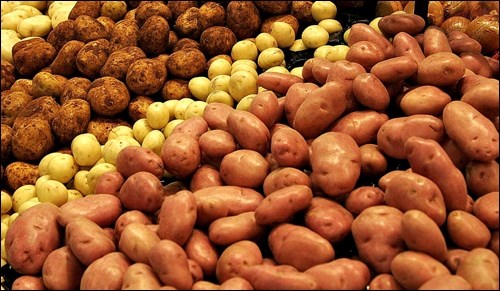This column is in honour of the potato— the mashed, the fried, the boiled, the baked, the stuffed and all the other ways we consume this lowly tuber. Who would think that a potato could be complex, but actually the potato is a vegetable of many faces.
Potatoes have been an important part of our agriculture and horticulture industry for more than 150 years and Canadian growers put more than 146,000 hectares into potatoes with a whopping yield of over 4.5 million tonnes. There are more than 150 different varieties of potatoes grown coast to coast to meet the market demand. However, these potato types fit into some rather broad categories. There are russet, red, white, yellow, blue/purple, fingerling and petite. Read on to find your best potato for every culinary creation you make.
Russet potatoes are medium to large and usually rather oval in shape. The skin is a light to medium russet-brown colour with white to pale yellow flesh. It has a nice light and fluffy texture with a earthy but mild flavor. The sugar content is medium and it is best used for baking, frying, mashing or roasting. Some varieties that can be purchased include Russet Burbank, Amisk, Ranger, Belrus, Goldrush, Norgold Russet, Shepody and others.
Red potatoes are usually slightly smaller than the russet and often rounder. Their skin is smooth and red and the flesh is very white. They are subtly sweet and are best for roasting, mashing, salads, soups or stews. From the mashed potato connoisseur in my house, he swears they are the only potato that should be mashed. Some reds you might grow include Peregrine Red, Caribe, Norland, Viking and many more.
White potatoes are roundish and often flattened at the stem end. They have a smooth, light creamy buff skin and shallow eyes. They are high yielding and attractive and used for boiling, baking, chipping and frying. They are the potato of choice for French fries. Some varieties to grow include Abnaki, Cascade, Norchip, Sebago and more.
The yellow potato comes in a variety of sizes from marble to large, round to oblong with light tan to golden skin and yellow to golden flesh. Their texture is more velvety and moist with a richer buttery flavour. They are best used for grilling, roasting, mashing or salads. Some to try include Abnaki, Ptarmigan, Sierra, Yukon Gold and others.
The purple/blue potatoes also come in a variety of sizes from small to medium and oblong to fingerling shapes. Their skin colour can be bluish to red with blue, purple, lavender, pink or white flesh. They have a lower sugar content and a earthy or nutty flavor, not to mention the colour they add to the plate. Varieties to try are Adirondack Blue, Caribe, Michigan Purple, True Blue and more.
The fingerling potatoes are usually two to four inches long and are finger or oblong in shape. Their skin can be red, orange, purple or white with flesh that is red, orange, purple, yellow or white and even may be streaked in appearance. They are best pan-fried or roasted and make a beautiful salad.
The petite potatoes are small and bite sized and actually are a grade standard that is based on size. They are the same as their larger cousins in flavour, sugar content and texture so make a lovely addition to a meal. They are a conversation piece with each person likely picking a different favourite.
So you see there are many faces to the potato. Grow some new ones next year and have fun cooking with colour!
— Hanbidge is a horticulturist with the Saskatoon School of Horticulture and can be reached at 306-931-GROW(4769); by email at growyourfuture@gmail.com or check out our website at saskhort.com.



